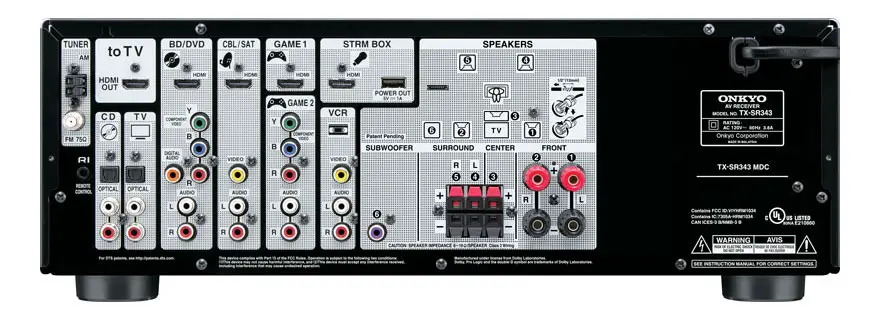This year is a big year for Onkyo because it will be the first time ever Onkyo will be launching new products after Pioneer sold their AV business to Onkyo. Pioneer-branded AV receivers will still live on but Onkyo’s launch is a much bigger deal. Onkyo has finally made the brave move to give their home theater receivers a noticeable overhaul. The awesome thing is that even their entry-level products like the Onkyo TX-SR343 have these noticeable changes.
About the Onkyo TX-SR343
The Onkyo TX-SR343 is the company’s most affordable home theater receiver in the new lineup and an obvious successor to the popular Onkyo TX-SR333. When comparing the spec sheets, the Onkyo TX-SR343 is quite similar to its predecessor for the most part. It supports up to 5.1 channels with 110 watts per channel making it clear that this receiver is for basic home theater setups without the added full expandability options to other rooms.
Comparison with the Onkyo TX-SR333
While the internals haven’t been changed all that much, both the front and the back of the TX-SR343 received major overhauls. Onkyo stuck with the same quality brushed aluminum materials but the button layout has been simplified. Left of the central display is the tuning knob with fewer buttons located just below the display and all properly labeled. Just below that thin row of buttons is another row of 11 curved buttons designed for easy input selection. The previous model had that row of buttons too but the labels are much clearer and the entire receiver as a whole looks more modern. The bottom right of the central panel also features dedicated buttons for adjusting the listening mode. The master volume, aux input and power buttons remain in their usual places.
The best part of the external overhaul can be found on the back of the Onkyo TX-SR343. The layout and grouping of the connection ports have not only been rearranged but the groups now have a white background so they are easier to spot. It is more newbie-friendly too as the speakers group shows a useful connection diagram depicting a recommended 5.1-channel speaker arrangement for the standard living room. Each HDMI port has its own section with bigger labels so average consumers really know what to do with each one. For instance, you can see the words “to TV” just above the HDMI output.
A small downside of the TX-SR343 is the reduced number of HDMI inputs from 6 to 4. However, all 4 of these ports support the new HDMI 2.0a standard which supports HDR. HDCP 2.2 support is also baked in all ports making even this entry-level receiver more futureproof than any of the older models regardless of ranking. This year’s 4K TVs and Blu-ray players are sure to play nice with this receiver.
One interesting change is the USB port positioned right next to fourth HDMI input. Both the HDMI port and USB ports are found in the same “STRM BOX” group suggesting that this HDMI port be used for streaming dongles like the Chromecast. Since these dongles rely on USB for power, the neighboring 1-amp USB port conveniently provides the necessary power without the wire clutter.
The Onkyo TX-SR343 doesn’t come with the fancy video up-converting features typically found in higher-end models but this new entry-level model can at least upconvert analog sources to better quality ones through HDMI. So if you still use your trusty VHS player and still have a massive collection of VHS tapes, you can hook up the player to the receiver and use an HDMI cable to connect the receiver to the TV. The end result is better picture quality for these vintage programs. These improvements are also responsible for the $100 increase in price.
Below is the back panel layout. Click on image to enlarge for a clearer view.
Features
For those not aware of the recent 4K boom, the HDMI 2.0a specification means that you can enjoy 4k VIDEO at the full 60 fps along with 4:4:4 color space. The built-in Bluetooth remains unchanged and is still stuck on 2.1 but it isn’t a big deal and you can pair up to 10 devices to the receiver.
Performance
Performance-wise, the TX-SR343 isn’t a huge step up from the older model but the TX-SR333 was pretty impressive on its own. The Onkyo TX-SR343 employs discrete amplifiers for dynamic and accurate audio reproduction. With the proven Burr-Brown DAC and familiar Wide Range Amplification Technology, audio quality for movies and music is great as long as the connected speakers meet the power requirements. Audiophiles will obviously prefer something with far more power but budget-conscious folks who have never set up a home theater receiver will like Onkyo’s new proposition.
Conclusion
Pros:
• The new front panel arrangement looks modern and fresh.
• The back panel facelift easily makes this receiver the easiest to set up.
• Works nicely with the latest HDMI streaming dongles.
• HDMI 2.0a support.
• Up-conversion of analog sources is a nice extra for an entry-level model.
Cons:
• No serious improvements on the audio quality compared to its predecessor.
• Only 4 HDMI ports.
• Costs $100 more than the previous model.
Verdict:
The $399 price tag is the most important thing to take note of with the Onkyo TX-SR343 especially since the now outdated TX-SR333 can sell for under $299. You will get the same performance without the HDCP 2.2 support but it still supports 4K and if you know how to set it up, the TX-SR333 might still be the true budget model to get. But the Onkyo TX-SR343 remains a huge deal simply because it finally freshens up the boring lineup of home theater receivers. Making their receivers more accommodating to set up will convince more people to build powerful home theater systems.
Update: There is a newer model > Onkyo TX-SR373


